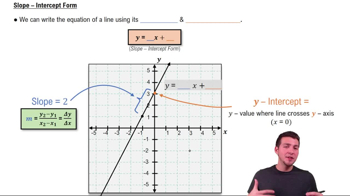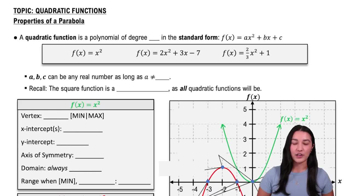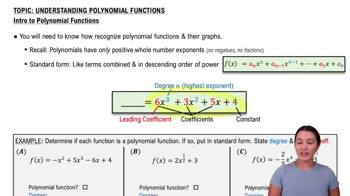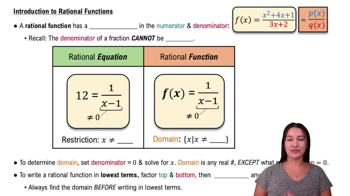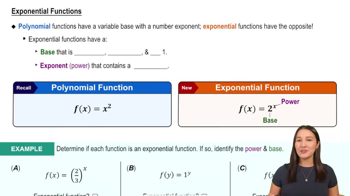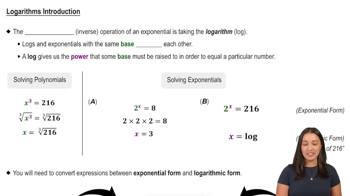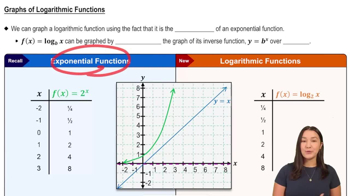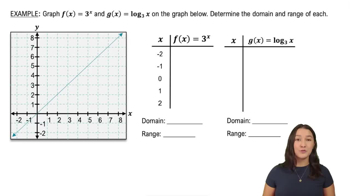Table of contents
- 0. Functions7h 52m
- Introduction to Functions16m
- Piecewise Functions10m
- Properties of Functions9m
- Common Functions1h 8m
- Transformations5m
- Combining Functions27m
- Exponent rules32m
- Exponential Functions28m
- Logarithmic Functions24m
- Properties of Logarithms34m
- Exponential & Logarithmic Equations35m
- Introduction to Trigonometric Functions38m
- Graphs of Trigonometric Functions44m
- Trigonometric Identities47m
- Inverse Trigonometric Functions48m
- 1. Limits and Continuity2h 2m
- 2. Intro to Derivatives1h 33m
- 3. Techniques of Differentiation3h 18m
- 4. Applications of Derivatives2h 38m
- 5. Graphical Applications of Derivatives6h 2m
- 6. Derivatives of Inverse, Exponential, & Logarithmic Functions2h 37m
- 7. Antiderivatives & Indefinite Integrals1h 26m
- 8. Definite Integrals4h 44m
- 9. Graphical Applications of Integrals2h 27m
- 10. Physics Applications of Integrals 2h 22m
0. Functions
Common Functions
Problem 77f
Textbook Question
Explain why or why not Determine whether the following statements are true and give an explanation or counterexample.
If , then .
 Verified step by step guidance
Verified step by step guidance1
Step 1: Understand the definition of an inverse function. For a function \( f(x) \), its inverse \( f^{-1}(x) \) satisfies the condition \( f(f^{-1}(x)) = x \) and \( f^{-1}(f(x)) = x \).
Step 2: Consider the given function \( f(x) = x^2 + 1 \). To find its inverse, we would typically solve the equation \( y = x^2 + 1 \) for \( x \) in terms of \( y \).
Step 3: Rearrange the equation \( y = x^2 + 1 \) to solve for \( x \): \( x^2 = y - 1 \). Then, \( x = \pm \sqrt{y - 1} \).
Step 4: Notice that the expression \( x = \pm \sqrt{y - 1} \) implies that \( f(x) = x^2 + 1 \) is not one-to-one, as it does not pass the horizontal line test. Therefore, it does not have an inverse function over the entire set of real numbers.
Step 5: The statement \( f^{-1}(x) = \frac{1}{x^2 + 1} \) is incorrect because the expression given does not satisfy the conditions for an inverse function of \( f(x) = x^2 + 1 \). A counterexample is that substituting \( x = 0 \) into \( f(x) \) gives \( f(0) = 1 \), but substituting \( x = 1 \) into \( f^{-1}(x) \) gives \( \frac{1}{2} \), which does not satisfy the inverse condition.
 Verified video answer for a similar problem:
Verified video answer for a similar problem:This video solution was recommended by our tutors as helpful for the problem above
Video duration:
1mPlay a video:
Was this helpful?
Key Concepts
Here are the essential concepts you must grasp in order to answer the question correctly.
Function and Inverse Function
A function maps each input to a single output, while an inverse function reverses this mapping. For a function f(x), its inverse f⁻¹(x) satisfies the condition f(f⁻¹(x)) = x for all x in the domain of f⁻¹. Understanding this relationship is crucial for determining whether the proposed inverse function is correct.
Recommended video:

Derivatives of Other Inverse Trigonometric Functions
One-to-One Function
A function is one-to-one (injective) if it never assigns the same value to two different domain elements. This property is essential for a function to have an inverse. If f(x) = x² + 1 is not one-to-one, it cannot have a valid inverse, which is a key consideration in evaluating the given statements.
Recommended video:

One-Sided Limits
Counterexample
A counterexample is a specific case that disproves a statement or proposition. In the context of functions, providing a counterexample involves finding an input that leads to the same output for different inputs, thereby demonstrating that the function is not one-to-one. This is a critical tool in validating or refuting claims about functions and their inverses.

 5:57m
5:57mWatch next
Master Graphs of Common Functions with a bite sized video explanation from Nick
Start learningRelated Videos
Related Practice



